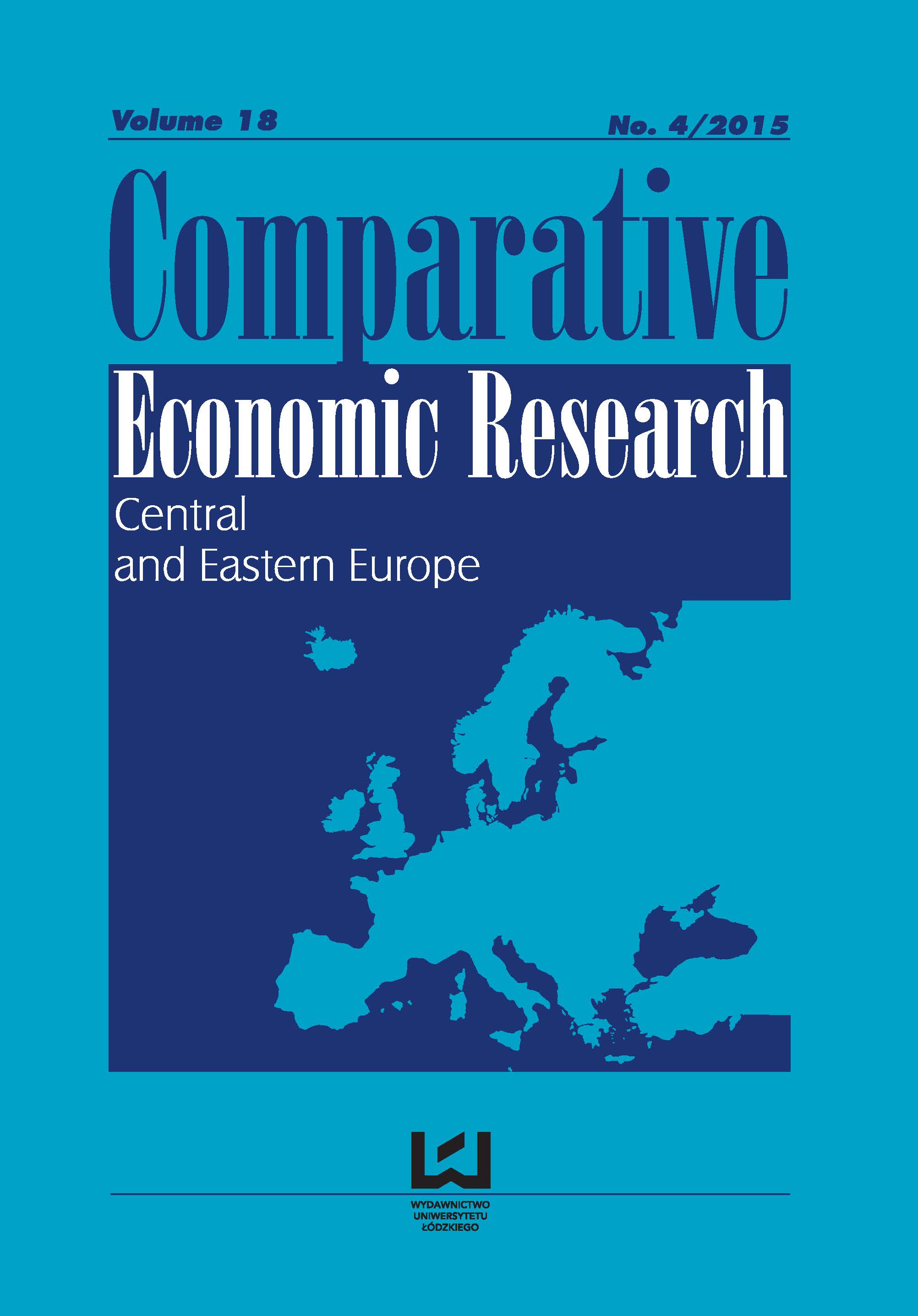Long-term Sustainability Of Public Finance In The Central And Eastern EU Member States
DOI:
https://doi.org/10.1515/cer-2015-0028Keywords:
public debt, primary net lending, sustainabilityAbstract
The main goal of this article is to investigate the level of long-term sustainability of public finance in the Central and Eastern EU Member States. This aim is accompanied by the following hypothesis: an inability to generate primary surpluses and significantly growing public debt volumes prevent the attainment of sustainability in the area of public finance. The research method is based on GDP and public debt growth rates, as well as on the values of discounted primary fiscal balances at the actual and structural level. The research period covers the years 2000-2014. Data were taken from Eurostat, the European Commission's Directorate General for Economic and Financial Affairs and the European Central Bank.
Downloads
References
Baglioni A., Cherubini U. (1993), Intertemporal budget constraint and public debt sustainability: the case of Italy, ‘Applied Economics’, Vol. 25, Issue 2. doi: 10.1080/00036849300000033
Google Scholar
Barro R. J. (1974), Are Government Bonds Net Wealth?, ‘Journal of Political Economy’, Vol. 82, Issue 6. doi: 10.1086/260266
Google Scholar
Barro R. J. (1989), The Ricardian Approach to Budget Deficits, ‘Journal of Economic Perspectives, Vol. 3, Issue 2. doi: 10.1257/jep.3.2.37
Google Scholar
Cyclical Adjustment of Budget Balances (2013), European Commission, Directorate-General for Economic and Financial Affairs.
Google Scholar
Denis C., Mc Morrow K., Röger W. (2002), Production function approach to calculating potential growth and output gaps - estimates for the EU Member States and the US, European Commission, Directorate-General for Economic and Financial Affairs, ‘Economic Papers’, no. 176.
Google Scholar
Fan J., Arghyrou M. G. (2013), UK Fiscal Policy Sustainability, 1955-2006, The Manchester School, Vol. 81, Issue 6. DOI: . doi: 10.1111/j.1467-9957.2012.02319.x
Google Scholar
Gali J. (2013), Notes for a New Guide to Keynes (I): Wages, Aggregate Demand, and Employment, ‘Journal of the European Economic Association’, Vol. 11, Issue 5. DOI: . doi: 10.1111/jeea.12032
Google Scholar
Gevorkyan A. V. (2010), Fiscal Policy in Transition Economies: Opportunities for Sustainable Development, ‘Proceedings of the Northeast Business & Economics Association’.
Google Scholar
Hall R. E. (2014), Fiscal Stability of High-Debt Nations under Volatile Economic Conditions, ‘German Economic Review’, Vol. 15, Issue 1. doi: 10.1111/geer.12025
Google Scholar
Heller P. S. (2003), Who Will Pay? Coping with Aging Societies, Climate Change, and Other Long-Term Fiscal Challenges, International Monetary Fund.
Google Scholar
Józefiak C., Krajewski P., Mackiewicz M. (2006), Deficyt budżetowy. Przyczyny i metody ograniczenia, PWE, Warszawa.
Google Scholar
Kwiatkowski E. (2002), Bezrobocie. Podstawy teoretyczne, PWN, Warszawa.
Google Scholar
Laffargue J-P. (2009), Intergenerational Transfers and the Stability of Public Debt with Short- Lived Governments, ‘Mathematical Population Studies’, Vol. 16, Issue 1. doi: 10.1080/08898480802619686
Google Scholar
Lindbeck A. & Weibull J. W. (1986), Intergenerational Aspects of Public Transfers, Borrowing and Debt, ‘Scandinavian Journal of Economics’, Vol. 88, Issue 1. doi: 10.2307/3440288
Google Scholar
Martins-da-Rocha V-F., Vailakis Y. (2012), On Ponzi games in infinite horizon collateralized economies with default penalties, ‘Annals of Finance’, Vol. 8, Issue 4. DOI: . doi: 10.1007/s10436-012-0209-y
Google Scholar
Miles D., Cerny A. (2006), Risk, return and portfolio allocation under alternative pension systems with incomplete and imperfect financial markets, ‘Economic Journal’, Vol. 116, Issue 511. DOI: . doi: 10.1111/j.1468-0297.2006.01091.x
Google Scholar
Minea A. & Villieu P. (2010), Endogenous growth, government debt and budgetary regimes: A Corrigendum, ‘Journal of Macroeconomics’, Vol. 32, Issue 2. DOI: . doi: 10.1016/S0164-0704(00)00136-1
Google Scholar
Molendowski E., Stanek P. (2012), Globalny kryzys finansowo-gospodarczy i strefy euro a sytuacja fiskalna nowych państw członkowskich (UE-10), ‘Acta Universitatis Lodziensis Folia Oeconomica”, No. 273.
Google Scholar
Neck R., Sturm J-E. (2008), Sustainability of Public Debt, Cambridge, Massachusetts Institute of Technology, Massachusetts.
Google Scholar
Pastor J., Villagomez A. (2007), The structural budget balance: a preliminary estimation for Mexico, ‘Applied Economics’, Vol. 39, Issue 12. doi: 10.1080/00036840500447856
Google Scholar
Qin D., Cagas M. A., Ducanes G., Magtibay-Ramos N., Quising P. (2006), Empirical assessment of sustainability and feasibility of government debt: The Philippines case. ‘Journal of Asian Economics’, Vol. 17, Issue 1. DOI: . doi: 10.1016/j.asieco.2005.12.003
Google Scholar
Rowley C. K., Shughart W. F., Tollison R.D. (eds.) (2002), The Economics of Budget Deficits, Edward Elgar, Cheltenham.
Google Scholar
Slavin R. (2013), Nassau County, N.Y., Passes Budget with 8.1% Structural Deficit, ‘Bond Buyer’, 30 October.
Google Scholar
Socol A-G. (2013), Romania's road to Euro zone. From structural balance to structural balance corrected for absorption, ‘Theoretical & Applied Economics’, Vol. 20, Issue 2.
Google Scholar
Sterks, C. G. M. (1984), The Structural Budget Deficit as an Instrument of Fiscal Policy, ‘De Economist’, Vol. 132, Issue 2. doi: 10.1007/BF02380298
Google Scholar
Uryszek T. (2014), Międzypokoleniowa redystrybucja długu publicznego na przykładzie krajów Unii Europejskiej, ‘Prace Naukowe Uniwersytetu Ekonomicznego we Wrocławiu’, no. 330.
Google Scholar
Uryszek T. (2012), Modele zarządzania długiem publicznym a ryzyko refinansowania w krajach Unii Europejskiej, [in:] Danuta Kopycińska (ed.), Wyzwania ekonomiczne XXI wieku, ZAPOL, Szczecin.
Google Scholar
Uryszek T. (2011), Saldo pierwotne a stabilność sektora finansów publicznych w wybranych krajach Unii Europejskiej, ‘Prace i Materiały Wydziału Zarządzania Uniwersytetu Gdańskiego’, no. 4(4).
Google Scholar
Wigger B. U. (2009), A note on public debt, tax-exempt bonds, and Ponzi games, ‘Journal of Macroeconomics’, Vol. 31, Issue 3. DOI: . doi: 10.1016/j.jmacro.2008.07.003
Google Scholar
Williams D. W., Onochie J. (2013), The Rube Goldberg Machine of Budget Implementation, or Is There a Structural Deficit in the New York City Budget?, ‘Public Budgeting & Finance’, Vol. 33, Issue 4.
Google Scholar
Yuhua Q. (2006), Structural Deficits and the Politics of Balancing the Budget: the Case of Missouri FY 2004 Budget, ‘Journal of Public Budgeting, Accounting & Financial Management’, Vol. 18, Issue 3.
Google Scholar
Downloads
Published
How to Cite
Issue
Section
License

This work is licensed under a Creative Commons Attribution-NonCommercial-NoDerivatives 4.0 International License.











